When it comes to roofing materials, slate is widely regarded for its durability, aesthetic appeal, and longevity. One of the standout features of a slate roof is its ability to effectively manage water drainage and moisture control, making it an ideal choice for homes in areas prone to heavy rainfall. In this article, we will explore how slate roofs contribute to better water drainage and moisture management, and why they could be the right choice for your property.
Natural Water-Resistant Qualities
Slate is a naturally water-resistant material, making it an excellent option for preventing moisture from penetrating the roof structure. Unlike some other roofing materials, slate does not absorb water, reducing the risk of water damage to the roof and the underlying structure. This characteristic helps to maintain the integrity of the roof over time, preventing issues such as rot, mould, and rust which can occur in materials that retain moisture.
In addition to being water-resistant, slate tiles have a smooth surface, which allows rainwater to flow off more efficiently. This ensures that water does not pool on the roof, reducing the risk of leaks and extending the life of the roof.
Proper Angling and Overlapping for Effective Drainage
One of the main factors that contribute to better water drainage with slate roofs is the design and installation of the tiles. Slate tiles are typically installed with a slight slope to encourage the flow of rainwater off the roof. This angle ensures that water does not accumulate on the surface but instead drains away quickly, helping to prevent the build-up of moisture that could cause long-term damage.
Additionally, slate tiles are overlapped during installation to create a watertight seal. Each tile sits slightly over the one beneath it, preventing water from seeping through the gaps. This overlapping technique is especially important in areas with heavy rainfall or wind-driven rain, where water can be driven upwards and under the tiles if not properly secured.
Improved Ventilation for Moisture Control
Slate roofs are known for their ability to allow air circulation and promote proper ventilation. Ventilation is a crucial component in moisture management as it helps to regulate the temperature and humidity levels within the roof space. By allowing moisture-laden air to escape and fresh air to circulate, slate roofs help to prevent the build-up of condensation, which can contribute to mould, mildew, and wood rot.
This natural ventilation also works to keep the attic space dry and prevents moisture from accumulating, ensuring the structural integrity of your home. In areas with high humidity, proper ventilation and moisture control are essential for maintaining a healthy indoor environment.
Durability Against Weather Extremes
Slate roofs are renowned for their ability to withstand extreme weather conditions, including heavy rain, snow, and strong winds. This makes them an ideal choice for homes in areas like Dartford, Kent, where unpredictable weather can cause problems for less durable roofing materials. The durability of slate tiles means they are less likely to suffer from damage that could compromise their water management capabilities.
Moreover, slate’s resistance to thermal expansion and contraction ensures that it maintains its shape and function over time, even in fluctuating temperatures. This consistency is key in ensuring that water continues to flow smoothly off the roof and does not get trapped in areas where it could cause issues.
Long-Term Benefits for Moisture Management
Investing in a slate roof not only provides immediate benefits for water drainage and moisture control, but it also offers long-term advantages. Slate is a highly durable material that can last for over a century with proper care and maintenance. This means that homeowners can enjoy continued protection from moisture and water damage for decades, making it a sound investment for long-term property value and peace of mind.
Regular maintenance of a slate roof, such as clearing gutters and checking for damaged tiles, can further enhance its ability to manage water drainage and moisture. With the right care, a slate roof can provide reliable protection for your home for many years, contributing to a dry, secure, and well-maintained living space.
Conclusion
Slate roofs are a reliable, long-lasting, and effective solution for managing water drainage and moisture control. Their natural water-resistant qualities, effective drainage system, and ability to allow for ventilation make them a smart choice for homes in areas prone to rainfall. In addition, their resilience to extreme weather conditions ensures that they will continue to provide protection for many years to come. If you’re looking to improve your home’s water management and protect your property from the elements, investing in a slate roof could be the right choice.
If you’re interested in learning more about how a slate roof can benefit your property or need professional roofing services in Dartford, Kent, don’t hesitate to contact us at Dartford Roofing Repairs. Our expert team is ready to help with all your roofing needs, from installations to repairs, ensuring your home remains dry, secure, and well-protected. Reach out today for a consultation!
Call us on: 01322 952 298
Click here to find out more about Dartford Roofing Repairs
Click here to complete our contact form and see how we can help with your roofing needs.

